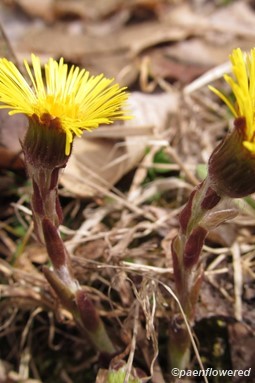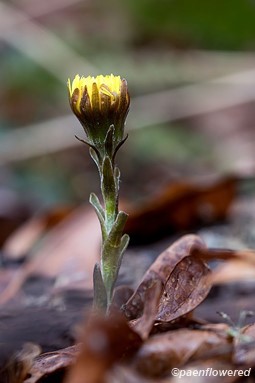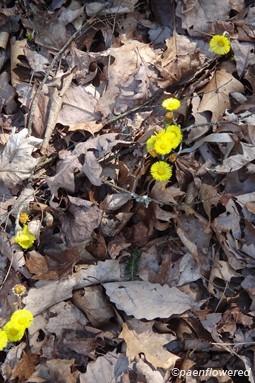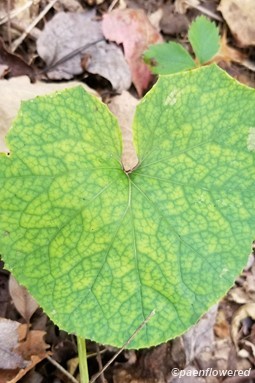Tussilago farfara
A common spring plant from Eurasia
Tussilago farfara coltsfoot
Coltsfoot is one of the earliest blooming wildflowers of the spring. It often is often mistaken for a dandelion, but has distinct differences when viewed closely. Although the composite flower of this member of the aster family superficially resembles those of the dandelion, they contain both disk and ray florets. The dandelion only contains ray florets. That means the coltsfoot has a somewhat distinct central disk. Both disk and ray florets of coltsfoot are yellow, making the disk a bit difficult to distinguish. The disk florets of coltsfoot are sterile. Such composite flowers actually are clusters of flowers, with each "petal," being a complete flower or floret. The entire cluster of these florets is called a flower head. The entire flower head of coltsfoot can be 1 to 1.25 inches in diameter.
The coltsfoot flowers emerge early in the spring from February to June borne on top of stalks covered with reddish scales. These stalks can be 6-18 inches tall. These stem scales are another distinct difference between coltsfoot and the dandelion—a species that has smooth flower stalks. The seeds that are formed by coltsfoot are achenes, and have a tuft of hair for wind dispersal much like those of the dandelion. The basal leaves of coltsfoot do not grow until later. These leaves are large and heart-shaped and are supposed to resemble a colt’s foot. The leaves are white and hairy on the underside. The coltsfoot plant can form colonies, spreading from underground rhizomes. They also have a branched taproot.
Coltsfoot is an introduced species, native to Eurasia. It is now widespread in North America, especially in the Northeast and in the State of Washington. It is also found in eastern Canada and British Colombia. Early colonists to America brought this plant as a medicinal herb. This is one of those species that seems to do well in association with humans. They are most often found growing in waste areas and thus are abundant along roadsides, on roadsides and in vacant lots, but can show up in many diverse habitats, including wetlands and wood lots. Many consider the emergence of these flowers as one of the first signs of spring.
In folk medicine, an extract of the leaves is made into cough drops or hard candy and the dried leaves into a tea often sweetened with honey. An extract from the stem was made into a preparation called “Syrup of coltsfoot” once recommended for chronic bronchitis. It was also an ingredient in herbal tobacco, smoked to treat asthma. None of these treatments has been scientifically confirmed.
Habitat & Range
Frequently found on roadsides, wasteplace, by railroads, stream banks.
Present throughout the state.
| EMP: | FACU |
|---|---|
| NCNE: | FACU |
Phenology
Flowers March through June.







Comments
Have you spotted this plant in your area? We'd love to hear about your experience! Share your comments or questions about the plant below. Comments are moderated before posting.